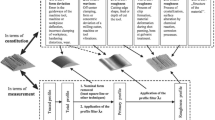Abstract
In manufacturing environment prediction of surface roughness is very important for product quality and production time. For this purpose, the finite element method and neural network is coupled to construct a surface roughness prediction model for high-speed machining. A finite element method based code is utilized to simulate the high-speed machining in which the cutting tool is incrementally advanced forward step by step during the cutting processes under various conditions of tool geometries (rake angle, edge radius) and cutting parameters (yielding strength, cutting speed, feed rate). The influences of the above cutting conditions on surface roughness variations are thus investigated. Moreover, the abductive neural networks are applied to synthesize the data sets obtained from the numerical calculations. Consequently, a quantitative prediction model is established for the relationship between the cutting variables and surface roughness in the process of high-speed machining. The surface roughness obtained from the calculations is compared with the experimental results conducted in the laboratory and with other research studies. Their agreements are quite well and the accuracy of the developed methodology may be verified accordingly. The simulation results also show that feed rate is the most important cutting variable dominating the surface roughness state.
Similar content being viewed by others
Reference
H. Gökkaya and M. Nalbant, The effects of cutting tool geometry and processing parameters on the surface roughness of AISI 1030 steel,Mater. Des. 28(2007)717–721.
Q. Colak, C. Kurbanoglu and M.C. Kayacan, Milling surface roughness prediction using evolutionary programming methods,Mater. Des. 28 (2007) 657–666.
H. Oktem, T. Erzurumlu and F. Erzincanli, Prediction of minimum surface roughness in end milling mold parts using neural network and genetic algorithm,Mater. Des. 27 (2006) 735–744.
H. Öktem, T. Erzurumlu and H. Kurtaran, Application of response surface methodology in the optimization of cutting conditions for surface roughness,J. Mater. Process. Technol. 170 (2005) 11–16.
B. Ozcelik and M. Bayramoglu, The statistical modeling of surface roughness in high-speed flat end milling,Int. J. Mack. Tools Manuf. 46 (2006) 1395–1402.
E.D. Kirby, J.C. Chen and J.Z. Zhang, Development of a fuzzy-nets-based in-process surface roughness adaptive control system in turning operations,Expert Syst. Appl. 30 (2006) 592–604.
T. Özel and Y. Karpat, Predictive modeling of surface roughness and tool wear in hard turning using regression and neural networks,Int. J. Mach. Tools Manuf. 45 (2005) 467–479.
H. Hocheng and M.L. Hsieh, Signal analysis of surface roughness in diamond turning of lens molds,Int. J. Mach. Tools Manuf. 44 (2004) 1607–1618.
K.A. Risbood, U.S. Dixit and A.D. Sahasrabudhe, Prediction of surface roughness and dimensional deviation by measuring cutting forces and vibrations in turning process,J. Mater. Process. Technol. 132 (2003) 203–214.
P.G. Benardos and G.C. Vosniakos, Prediction of surface roughness in CNC face milling using neural networks and Taguchi’s design of experiments,Robot Comput. Integr. Manuf. 18 (2002) 343–354.
Y.H. Tsai, J.C. Chen and S.J. Lou, An in-process surface recognition system based on neural networks in end milling cutting operations,Int. J. Mach. Tools Manuf. 39 (1999) 583–605.
W.T. Chien and C.T. Chou, The predictive model for machinability of 304 stainless steel,J. Mater. Process. Technol. 118 (2001) 442–447.
T.S. Huang, The investigation on the predictive model for the cutting forces and the optimized cutting parameters based on cutting SKD61, M.S. dissertation NPUST, Taiwan (2001).
A.R. Barron, Predicted square error: A criterion for automatic model selection, self-organizing methods in modeling: GMDH type algorithms, edited by Farlow, S. J. Marcei-Dekker, New York (1984).
Author information
Authors and Affiliations
Corresponding author
Rights and permissions
About this article
Cite this article
Lin, S.Y., Cheng, S.H. & Chang, C.K. Construction of a surface roughness prediction model for high speed machining. J Mech Sci Technol 21, 1622–1629 (2007). https://doi.org/10.1007/BF03177385
Received:
Revised:
Accepted:
Issue Date:
DOI: https://doi.org/10.1007/BF03177385




